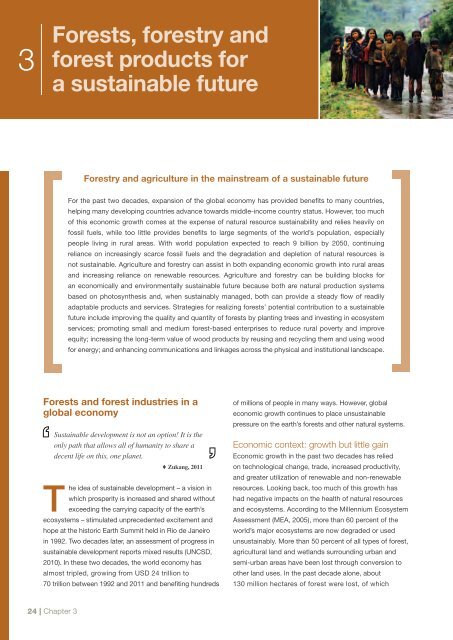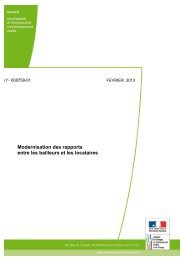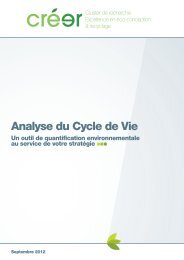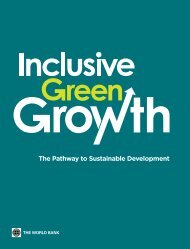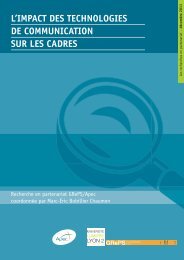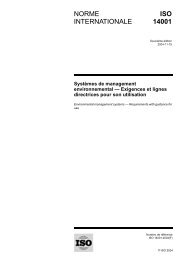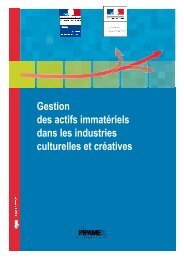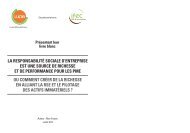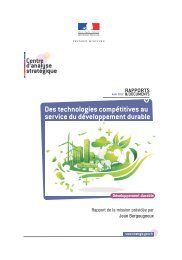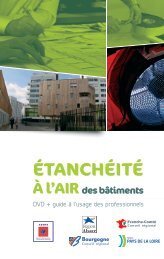3<strong>Forests</strong>, forestry andforest products fora sustainable futureForestry and agriculture in <strong>the</strong> mainstream <strong>of</strong> a sustainable futureFor <strong>the</strong> past two decades, expansion <strong>of</strong> <strong>the</strong> global economy has provided benefits to many countries,helping many developing countries advance towards middle-income country status. However, too much<strong>of</strong> this economic growth comes at <strong>the</strong> expense <strong>of</strong> natural resource sustainability and relies heavily onfossil fuels, while too little provides benefits to large segments <strong>of</strong> <strong>the</strong> world’s population, especiallypeople living in rural areas. With world population expected to reach 9 billion by 2050, continuingreliance on increasingly scarce fossil fuels and <strong>the</strong> degradation and depletion <strong>of</strong> natural resources isnot sustainable. Agriculture and forestry can assist in both expanding economic growth into rural areasand increasing reliance on renewable resources. Agriculture and forestry can be building blocks foran economically and environmentally sustainable future because both are natural production systemsbased on photosyn<strong>the</strong>sis and, when sustainably managed, both can provide a steady flow <strong>of</strong> readilyadaptable products and services. Strategies for realizing forests’ potential contribution to a sustainablefuture include improving <strong>the</strong> quality and quantity <strong>of</strong> forests by planting trees and investing in ecosystemservices; promoting small and medium forest-based enterprises to reduce rural poverty and improveequity; increasing <strong>the</strong> long-term value <strong>of</strong> wood products by reusing and recycling <strong>the</strong>m and using woodfor energy; and enhancing communications and linkages across <strong>the</strong> physical and institutional landscape.<strong>Forests</strong> and forest industries in aglobal economySustainable development is not an option! It is <strong>the</strong>only path that allows all <strong>of</strong> humanity to share adecent life on this, one planet.♦♦Zukang, 2011The idea <strong>of</strong> sustainable development – a vision inwhich prosperity is increased and shared withoutexceeding <strong>the</strong> carrying capacity <strong>of</strong> <strong>the</strong> earth’secosystems – stimulated unprecedented excitement andhope at <strong>the</strong> historic Earth Summit held in Rio de Janeiroin 1992. Two decades later, an assessment <strong>of</strong> progress insustainable development reports mixed results (UNCSD,2010). In <strong>the</strong>se two decades, <strong>the</strong> world economy hasalmost tripled, growing from USD 24 trillion to70 trillion between 1992 and 2011 and benefiting hundreds<strong>of</strong> millions <strong>of</strong> people in many ways. However, globaleconomic growth continues to place unsustainablepressure on <strong>the</strong> earth’s forests and o<strong>the</strong>r natural systems.Economic context: growth but little gainEconomic growth in <strong>the</strong> past two decades has reliedon technological change, trade, increased productivity,and greater utilization <strong>of</strong> renewable and non-renewableresources. Looking back, too much <strong>of</strong> this growth hashad negative impacts on <strong>the</strong> health <strong>of</strong> natural resourcesand ecosystems. According to <strong>the</strong> Millennium EcosystemAssessment (MEA, 2005), more than 60 percent <strong>of</strong> <strong>the</strong>world’s major ecosystems are now degraded or usedunsustainably. More than 50 percent <strong>of</strong> all types <strong>of</strong> forest,agricultural land and wetlands surrounding urban andsemi-urban areas have been lost through conversion too<strong>the</strong>r land uses. In <strong>the</strong> past decade alone, about130 million hectares <strong>of</strong> forest were lost, <strong>of</strong> which24 | Chapter 3
40 million hectares were primary forests (FAO, 2010b).This forest loss and degradation are estimated to cost <strong>the</strong>global economy between USD 2 trillion and 4.5 trilliona year (Sukhdev, 2010). Unfortunately, such costs arenot captured in traditional measures <strong>of</strong> economicprogress such as gross domestic product (GDP)(World Bank, 2011c).■■Mangrove forest destroyed by tin mining activities,Thailand. More than 60 percent <strong>of</strong> <strong>the</strong> world’s majorecosystems are now degraded or used unsustainablyIn addition, <strong>the</strong> benefits <strong>of</strong> economic progress have notbeen equitably shared. The absolute number <strong>of</strong> peopleliving in extreme poverty rose by 36 million between1990 and 2005. 8 The number <strong>of</strong> undernourished peopleincreased from 817 million in 1990 to 830 million in 2007(UN, 2010) and has continued to climb (FAO, 2010b).A fifth <strong>of</strong> <strong>the</strong> population in <strong>the</strong> developing world still lacksaccess to sufficient clean water (UNICEF/WHO, 2012) anda quarter lack modern energy services (IEA, 2010). Noninclusive,rapid economic growth that undermines people’slivelihoods through resource depletion has become amajor cause <strong>of</strong> political and social unrest in many parts <strong>of</strong><strong>the</strong> world. The need to feed a growing population and <strong>the</strong>effects <strong>of</strong> global climate change are expected to put fur<strong>the</strong>rpressure on natural resources (FAO, 2011b). The promise<strong>of</strong> a sustainable future – where economic prosperity isshared broadly and achieved without compromisingnatural capital – is still to be realized.Solving old and new challenges will require humaningenuity and creativity. It will also need an approach thatmakes better and greater use <strong>of</strong> renewable resources,increases <strong>the</strong> resilience and diversity <strong>of</strong> productionsystems, and provides for broader sharing <strong>of</strong> economicwealth. Although most <strong>of</strong> <strong>the</strong> world’s population nowlives in urban areas, most <strong>of</strong> <strong>the</strong> world’s poor peoplelive in rural areas, so a greater focus on rural inclusionand rural development is essential. <strong>Forests</strong>, forestry andforest products are uniquely positioned to complemento<strong>the</strong>r agricultural activities in contributing to a sustainablefuture that will address <strong>the</strong> needs for both sustainableeconomic growth and economic and social justice.Globalization and o<strong>the</strong>r factorsThe forest sector, including forest management,timber harvesting and industries manufacturing timberbasedproducts, represents a small component <strong>of</strong>most national economies. At <strong>the</strong> global level, <strong>the</strong> sectorcontributes about 1.0 percent <strong>of</strong> GDP and employsabout 0.4 percent <strong>of</strong> <strong>the</strong> total labour force (FAO, 2008).8Excluding data from China, where <strong>the</strong>re have been significant gains inpoverty reduction.However, <strong>the</strong> aggregate data mask considerabledifferences among regions and among countriesin each region; in some developed as well as developingcountries, <strong>the</strong> forest sector accounts for a larger share<strong>of</strong> <strong>the</strong> national economy, 9 and in rural areas in severalcountries it accounts for significant shares <strong>of</strong> economicactivity and employment. Unfortunately, <strong>the</strong>se data donot take into account <strong>the</strong> provision <strong>of</strong> ecosystem servicessuch as watershed protection and erosion prevention,or <strong>the</strong> contribution <strong>of</strong> informal activities such as <strong>the</strong>production <strong>of</strong> woodfuel and non-wood forest products(NWFPs). At least ten million people are employed inforest management and conservation (FAO, 2010b),and an estimated 1 billion people depend on forests forsubsistence, as an economic safety net or as a directsource <strong>of</strong> income (Scherr, White and Kaimowitz, 2004).Forest industries face a variety <strong>of</strong> significant challengesarising from <strong>the</strong> lingering effects <strong>of</strong> <strong>the</strong> global economiccrisis and <strong>the</strong> slow recovery in demand for constructionmaterials, packaging material and furniture. 10 Many <strong>of</strong><strong>the</strong>se challenges reflect long-term, broad-scale trendsin <strong>the</strong> sector, in addition to <strong>the</strong> issues that face allindustries, such as increasingly integrated and competitiveinternational markets (globalization), excess productioncapacity and competition for resources. Although <strong>the</strong>environmental attributes <strong>of</strong> wood products presentopportunities to produce and market environmentally9For example, <strong>the</strong> contribution <strong>of</strong> <strong>the</strong> forest sector to GDP in Canadais 2.7 percent, in Malaysia 3.0 percent, in Finland 5.7 percent,in Papua New Guinea 6.7 percent, and in Liberia 17.7 percent.10There is an extended discussion <strong>of</strong> <strong>the</strong>se issues in SOFO 2011(FAO, 2011d).FAO/M. Kashio/FO-6382<strong>Forests</strong>, forestry and forest products for a sustainable future | 25


